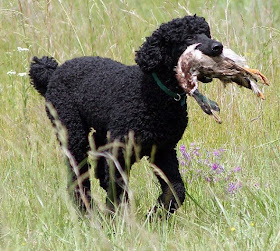 |
| Respect... Carol Fowler dog campaigner |
I first met Carol Fowler in 2007 when we were researching Pedigree Dogs Exposed. She was - and is - kind, softly-spoken, always respectful, a good listener and, delightfully, rather shockable (although this must be a front - as a former English teacher in the state school system, there can't be much she didn't hear in terms of extra-curricular vocabulary).
Carol often - with due cause it has to be said - shakes her head in some despair at me for being hopelessly disorganised and late for absolutely everything. She in contrast is always on time and meticulously organised. We are as different as different can be, and we don't agree on everything by any means, but there's undoubtedly a bond cemented through the common aim of improving dog welfare.
Carol lives in a beautiful little cottage in Gloucestershire with her Cavalier, Rosie. Rosie is her second Cavalier and, like her first, Bonnie, she suffers from syringomyelia, although not as hearbreakingly seriously as Bonnie. It was this experience that set Carol on the path she is now on.
When Bonnie was first diagnosed, Carol was shocked by her breeder's reaction (they threatened legal action if Carol spoke out about it), shocked by the breed club (little interest in documenting/highlighting the problem) and shocked by the Kennel Club for not having instigated any system for monitoring the level of genetic disease in individual breeds despite good evidence that there was a problem.
In her innocence, Carol thought that all she had to do was to raise the issue and that it would be sorted. She went to her MP and, together, they went to see the Kennel Club.
Carol remembers that they accused her of "pet-owner over-reaction".
Breeders, meanwhile, accused her of having Munchausen Syndrome by Proxy - as if this ineffably decent retired schoolteacher actually wanted her beloved pet dogs to scream with pain.
And throughout all this, Carol steered - and continues to steer - a steady path, never indulging in the kind of irreverent bitching about the dog world that has at times been a feature of gobbier campaigners like me. Instead, she has remained quietly persistent... writing letters, forging contacts, meeting welfare organisations, lobbying Government, educating herself regarding genetics and reading difficult scientific papers as often as is necessary to ensure she understands them. And she is always, but always, respectful and polite, however frustrated she may sometimes feel deep down.
So I am upset to see that the Chairman of the Kennel Club has trashed Carol Fowler in this week's Dog World in a column that is wanting in other ways too (a post to come on that shortly).
When I first met Carol, she was consumed with just Cavaliers. I remember asking her if she wanted to broaden it out, to champion the health of other breeds too. She didn't at the time, but as I rather expected, she has now - and impressively so with her dogbreedhealth website. Launched earlier this year and aimed primarily at the pet-buying public, the site offers independent, comprehensive information on health and welfare issues and available tests in individual breeds and crossbreeds, plus quite bit of useful general info (including a Beginner's Guide to COI written by me).
Carol has spent thousands of hours putting it together, all unpaid. Her starting point for establishing individual health problems was disease databases and veterinary texts. She then brought together several veterinary experts to review and comment on the drafts for each breed.
Now there is a flaw in this process and that is that the scientific/veterinary literature does not always reflect what is actually going on in particular breeds - a point, indeed, that Professor Dean is correct to make in his Dog World article this week.
As a result, the site was not perfect when Carol "soft-launched" it earlier this year. Some of the breed descriptions were (and still are, in truth) a bit clunky; there were some errors and it was in need of input from those on the ground in individual breeds - something that Carol states clearly on the homepage is invited.
But, on the plus side, the site brings together the relevant health lowdown on most popular breeds, as well as inbreeding information and what health tests are available (nowhere, incidentaly, does it suggest they are mandatory as Professor Dean claims in his article). Now I'm sure it reads too negatively for some breed enthusiasts, but on the other hand, the breed info offered by the KC's website is often laughably poor.
Let's have a quick compare.
Here's what the KC website says about pugs:
 |
| Click to enlarge |
When I first saw this, I thought there must be another page to it where they list brachycephalic airway syndrome, pug dog encephalitis, luxating patellas and the several other health problems to which pugs are prone. But, no, that's it. And, believe it or not, this page is from the dog breed health manual that the KC has produced for vets. The info for puppy-buyers doesn't include any health information on the breed at all.
In contrast, Carol's entry for the pug lists all the health problems above and more.
And how about Professor Dean's own breed, the Border Terrier? Here's what the KC vet manual says:
 |
| Click to enlarge |
According to the KC, there are no health problems. Nada. But while it's true that the Border Terrier is a tough, healthy breed compared to most, there are a few health problems - and these are listed on Carol's site. This allows puppy buyers to ask the right questions of breeders and awareness is helpful in terms of recognising a problem should it occur.
So Carol's site - although not perfect - is a genuinely-useful, gloss-free resource for puppy-buyers and Carol continues to improve it. She really does want it to be as good as possible and is constantly updating and refining it.
But instead of recognising the enormous effort - all unpaid - that Carol has put into it, and perhaps offering the KC's help to improve it further, here's what Professor Dean has said about it in his article this week:
"It suggests to the unsuspecting public (who believe much they read on the web) that certain health tests are mandatory. However, being based on amateur research there are many errors on this site and as a result misinformation will be provided to the public. This error is further compounded by endorsements from respected organisations who either did not have the resources to check the accuracy of the advice given or lacked the competence to judge it."
I really hate it when big people shit on little people - especially when the big person is part of an organisation that has been complicit in misinforming the public for decades by painting an over-rosy picture of the health of many breeds.
Let's note, too, that in 2008, the Kennel Club declined an opportunity to explore a disease surveillance scheme that would by now have yielded more accurate data on which Carol's site could be based. (It took funding from the RSPCA to finally get VetCompass off the ground.)
And let's also note that the Kennel Club has actively blocked Carol's attempts to improve her site.
Yes, they really did.
A few months ago, Carol wrote to the KC asking for a list of breed health co-ordinator (HCs) - the aim being to liaise with them to ensure that the information for each breed was up to date and accurate. By mistake, the KC's Bill Lambert copied Carol in on an email meant for internal consumption. Here's what he wrote to Aimee Lewellyn, who recently joined the KC as Health Information Manager.
"It goes without saying but the HC list is not available, and certainly not to her!"
Nice.
Now, to be fair, Bill Lambert apologised to Carol - who accepted it very graciously and she turned an awkward moment into a constructive one by directly asking for Bill Lambert's input on his own breed, the Bull Terrier. This was duly given and I trust Mr Lambert is now happier with the Bull Terrier entry - and if not that he'll continue discussion with Carol. After all, the site is here to stay - they might as well help to make it as accurate as possible.
As it happens, I wasn't ever intending to mention this KC faux-pas - after all, you ought to hear what I say about the KC behind its back! (Exactly the same as I say to its front, as it happens.) I know Carol will be mortified that I have. But I fear Professor Dean's piece this week reveals that, for all the talk of reform, deep-down there is still a core arrogance that resents what many at the KC still perceive as do-gooder outsiders meddling with stuff about which they don't have a clue.
Please. This needs to change. And it could start with an apology from Professor Dean to Carol Fowler.
















